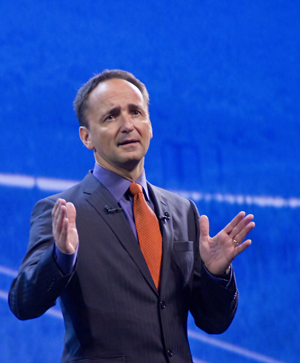SAP chief: Why in-memory computing is the future

Can Hana and her sisters replace the hard drive as the dominant computing architecture?
SAP co-CEO Jim Hagemann Snabe used his keynote at the Sapphire conference to promote the company's in-memory computing system, arguing it will be the dominant computer architecture of the future.

SAP co-CEO Jim Hagemann Snabe says in-memory computing is the way of the futureCreative Commons: Timo Elliott
In-memory computing involves processing data stored in computer memory rather than on a hard disk. Because of the speed at which data can be accessed from computer memory, and other technical innovations such as the use of parallel computer processors to carry out data analysis, in-memory computing can analyse data in a fraction of the time it takes using data stored in traditional relational databases on hard disks.
Snabe said in-memory computing will help businesses better predict customer demand and respond to threats to their bottom line faster. Tasks like calculating profitability and predicting stock levels that took hours using conventional analytics are being carried out in seconds using Hana, SAP's in-memory computing system, Snabe told SAP's Sapphire conference.
"In retail, companies are using in-memory computing to predict which products need to be in which store and at which time. In banks you can carry out real-time risk management - these are things which move an industry forward," he said.
"It is the idea that you will be able to answer any question you want in real time."
Snabe predicted that in-memory computing will be the dominant computer architecture in future, taking over from the separate hard drive and memory architecture that computers have today.
In-memory computing also allows organisations to slim down the computer infrastructure and software needed to carry out analytics, he said, as current analytics systems require the same data to be stored multiple times in order to answer different questions.
"It is a massive simplification of the infrastructure of a business warehouse - the data only needs to be stored once," he said.
Snabe said SAP had given 50 of its customers access to a Hana database to see how they...
...used the system to tackle particular challenges facing their business.
SAP plans to offer Hana-based analytics of 20 common business areas, starting with a Hana-based system to carry out profitability analysis which is available now.
SAP is also offering Hana-based business warehouse systems, and for an additional charge will offer its existing 12,000-plus business warehouse customers the chance to switch their data into a Hana database, Snabe said.
SAP's Snabe also discussed SAP's plans for mobile, cloud and its core ERP business at SapphireCreative Commons: Timo Elliott
While much of Snabe's speech focused on in-memory computing and Hana, he also discussed SAP's plans for mobile, cloud and its core ERP business.
Making data from SAP systems available through mobile devices is a priority for SAP, Snabe said, referencing the company's acquisition of mobile business intelligence specialist Sybase last year - and that SAP has developed more than 30 mobile apps to date. He added that SAP has more than 200 partner companies that are building mobile apps for SAP systems.
Snabe revealed that SAP's cloud-based ERP system Business ByDesign now has more than 700 customers and that the recently launched Business ByDesign app store has more than 70 pieces of software available. SAP will launch a new range of cloud-based systems targeting the needs of specific business departments in 2011 - which will focus on travel and expenses, HR, and sales.
Despite SAP's focus on in-memory computing, mobile and cloud, Snabe said that developing its core ERP business is still very important to the company. SAP has more than 32,000 customers using its core software worldwide, Snabe said, adding that the company is working with 1,500 of its customers to design software that incorporates the features its customers want in future releases.